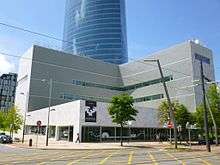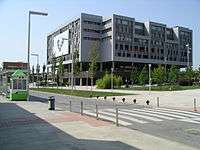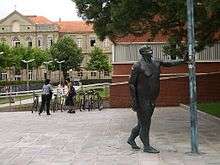University of the Basque Country
|
Universidad del País Vasco (UPV) Euskal Herriko Unibertsitatea (EHU) | |
 | |
| Motto | Eman ta zabal zazu (Give and extend knowledge) |
|---|---|
| Type | Public |
| Established | 1980 |
| Budget | 478 mill. eur (2010) |
| Rector | Pr. Iñaki Goirizelaia |
Academic staff | 3,420 (2009-2010)[1] |
| Students | 44,921 (2009-2010)[1] |
| Undergraduates | 42,026 (2009-2010)[1] |
| Postgraduates | 2,895 (2009-2010)[1] |
| Location |
Greater Bilbao Vitoria-Gasteiz San Sebastián and Eibar |
| Campus | Urban |
| Website | www.ehu.eus |
The University of the Basque Country (UPV/EHU) (Basque - Euskal Herriko Unibertsitatea (EHU); Spanish - Universidad del País Vasco (UPV)) is the only public university in the Basque Autonomous Community, in Northern Spain. It has campuses over the three provinces of the autonomous community: Biscay Campus (in Leioa, Bilbao, Portugalete and Barakaldo), Gipuzkoa Campus (in San Sebastián and Eibar), and Álava Campus in Vitoria-Gasteiz. It is the main research institution in the Basque Country, carrying out 90% of the basic research made in that territory and taking advantage of the good industrial environment that the region constitutes.
History

Although there have been numerous institutes of learning in the Basque country over the centuries, starting with the Universidad Sancti Spiritus de Oñati, it was not until the 20th century that serious efforts were made to create an official university for the Basque people. The first of these opened its doors in Bilbao in 1938, largely thanks to the zeal of the Basque president (lehendakari) at the time, José Antonio Aguirre, an alumnus of the University of Deusto. However, this was during the Spanish Civil War, and an inopportune moment to open a centre of learning. The northwest of the Basque region mostly sided with the Republican movement at this time, earning the wrath of General Francisco Franco. Thus, when Franco's armies entered Bilbao in 1939, the fledgling university was shut down.
It was not until 1968 that another university in the Basque region was founded. In this year, the University of Bilbao was opened. In 1972, the Leioa premises were finished. They were in a remote place among cultivated fields. As in the case of the Somosaguas campus of the Complutense University of Madrid, the dictatorial authorities wanted to keep the rebellious students away from urban areas. In 1977, additional campuses sprang up in Álava and Gipuzkoa. Finally, in 1980, the university was officially designated to be the University of the Basque Country.
As of 2005, 78 different degrees are offered, and the university's 48,000 students can choose from more than 1,300 subjects of study. One can study 43% of the courses in the Basque language. The university is now recognised as one of the foremost in Spain, both in terms of the number of degrees offered and the quality of the typical degree awarded.
In 2009 the UPV/EHU project "Euskampus", was labeled as "Campus of International Excellence", highest quality award by the Spanish Minister of Education. The project has been designed with the aggregation of two important international players: Tecnalia Research and Innovation Corporation and Donostia International Physics Center Foundation.
The current rector is Iñaki Goirizelaia. Former rectors:
- Gregorio Monreal
- Emilio Barberá
- Juan Jose Goiriena de Gandarias
- Pello Salaburu
- Manuel Montero
- Juan Ignacio Iglesias
Symbols
The motto of UPV/EHU is a Basque-language verse Eman ta zabal zazu ("Give and distribute [the fruit]"), from Gernikako Arbola, a Basque anthem from the 19th century.
The emblem of UPV/EHU is an interpretation of the Guernica oak by sculptor Eduardo Chillida.[2]
Campuses and structure
One of the characteristics of the university is the dispersion of its faculties and schools. The university contains three campuses, one for each of the three provinces of the Basque Autonomous Community.
Biscay Campus
Biscay Campus is the largest and the busiest campus; its main complex is in Leioa, eleven kilometres away from Bilbao's city centre, in the seat of the former University of Bilbao. Nonetheless, there are other centres and schools within Bilbao, in Barakaldo and in Portugalete. Since 2011, the university also has a representation centre, the Bizkaia Aretoa, in the Abandoibarra neighbourhood of Bilbao, which houses some of the university's offices but also congresses and expositions.
Leioa


- Faculty of Science and Technology
- Faculty of Medicine and Dentistry
- Faculty of Social Sciences and Communication
- Faculty of Fine Arts
- University School of Labour Relations Studies
- University School of Nursing of Leioa
- Faculty of Law - Biscay section
Bilbao
- Faculty of Economics and Business Studies
- University School of Technical Industrial Engineering of Bilbao
- Higher Technical School of Engineering
- University College of Technical Mining and Civil Engineering
- University College of Business Studies of Bilbao
- Teaching Unit of Medicine (Basurto Hospital)
- Experience Classrooms of Biscay
Portugalete
- Higher Technical School of Nautical Studies
Barakaldo
- Teaching Unit of Medicine (Cruces Hospital)
Gipuzkoa Campus
Gipuzkoa Campus is seated in San Sebastián and Eibar. In San Sebastián, faculties and schools that used to be spread out in the city have been grouped together in the neighbourhood of Ibaeta.
San Sebastián
- Faculty of Chemical Sciences
- Faculty of Law
- Faculty of Psychology
- Faculty of Philosophy and Education Science
- Faculty of Computer Engineering
- Higher Technical School of Architecture
- Polytechnic College of Donostia
- University College of Business Studies of Donostia-San Sebastián
- University School of Teacher Training of Donostia-San Sebastián
- University School of Nursing of San Sebastián
- Teaching Unit of Medicine of San Sebastián
- Experience Classrooms of San Sebastián
Eibar
- University School of Technical Industrial Engineering of Eibar
Álava Campus

Álava Campus is seated in the south of Vitoria:
- Faculty of Pharmacy
- Faculty of Arts
- University College of Engineering of Vitoria-Gasteiz
- University School of Teacher Training of Vitoria-Gasteiz
- University School of Social Work
- University College of Business Studies of Vitoria-Gasteiz
- Faculty of Physical Activity and Sport Science
- Teaching Unit of Medicine of Vitoria-Gasteiz
- Experience Classrooms of Vitoria-Gasteiz
Master and Doctoral School
The Master and Doctoral School is responsible for coordinating and managing doctoral programmes and interdisciplinary research training, as well as coordinating and managing official master's degrees, with exception of those with professional attributes. It is common to the three campuses.
Affiliated schools
There are three schools affiliated with UPV/EHU:
- University School of Nursing of Vitoria-Gasteiz, in Txagorritxu Hospital, Vitoria.
- University College of the Chamber of Commerce of Bilbao, in Bilbao.
- University School of Dual Engineering IMH, in Elgoibar.
Summer Courses
UPV/EHU conducts its Summer Courses, created in 1981, at the Miramar Palace in San Sebastián. They consist of a series of lectures, talks, courses, and master classes on diverse subjects from different areas of knowledge. World-renowned lecturers have been invited to the Summer Courses, as for example, Noam Chomsky in 2006.
Sports
UPV/EHU has an important handball team. The university also has a football team that played in the Spanish Tercera División, Grupo 4 in the 2006-2007 season. They finished 19th and were relegated to the regional divisions.
The Engineering School of Bilbao and the University of Deusto hold yearly rowing competitions on the Estuary of Bilbao, inspired by the Oxford Cambridge boat race.
English Language Distance Education
The University offers an English language, distance Postgraduate Diploma in International Election Observation and Electoral Assistance, the first official postgraduate qualification of its kind that provides advanced learning in electoral systems and electoral campaign processes, with a particular focus for those occurring in contexts of developing democracies or post-conflict situations. The programme is run in cooperation with many organisations in the field of election monitoring, such as The Carter Center, Electoral Reform International Services (ERIS), International Foundation for Electoral Systems (IFES), National Democratic Institute (NDI), the Organization of American States (OAS) and the OSCE Office for Democratic Institutions and Human Rights (ODIHR).[3]
SIA Master
The Master in Advanced Computing {{http://www.ehu.eus/es/web/sistemasinformaticosavanzados/aurkezpena}} offers an interdisciplinary graduate structured in two specialties covering a large part of the research areas in computer science. Its basic objective is to guide the student in any of the research, maintaining an overview and allowing a personal curriculum fit within the full range of courses. The specialty called Artificial Intelligence and Natural Interaction includes content from part of the field of computer science and addresses the principles, methods and applications of adaptive systems with intelligent behavior, including intelligent data processing, creating intelligent systems for various fields, multimodal interaction, artificial perception, automatic classification and data mining. The specialty Distributed Systems and Web is part of the Information Systems, Information Technology and Software Engineering. Its aim is to generate knowledge about the systems and technologies existing information and provide skills in developing applications for these systems, including the fundamentals of distributed systems, new techniques of software engineering and its application, particularly in the Internet field. Upon completion of the Master in Advanced Information Systems, students will have acquired the skills necessary to complete a doctoral thesis in one of the main areas covered by the two specialties that form. However, given the relevance and importance of the subjects taught, direct incorporation of these students does not rule out a professional activity in the field, thereby responding to the growing need for qualified researchers in the environment.
Other universities operating in the Basque Country
- Udako Euskal Unibertsitatea
- UPPA
- University of Deusto
- National University of Distance Education
- University of Navarre
- Universidad Pública de Navarra
- Mondragon University
- Musikene
See also
References
External links
- University of the Basque Country website
- Campus of Internacional Excellence, Euskampus
- Idex Bordeaux
- The University of the Basque Country's own account of its history (Spanish)
- University of Nevada's Centre for Basque Studies; article about the university's origins
- International university study page
- Máster SIA
Coordinates: 43°20′08″N 2°58′42″W / 43.33556°N 2.97833°W